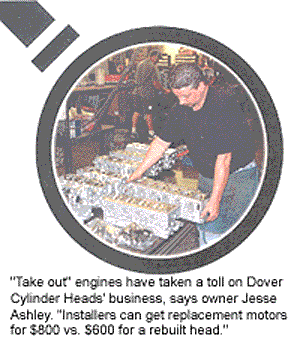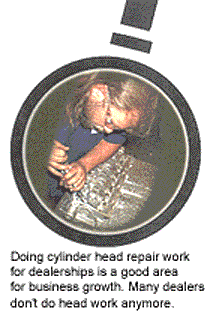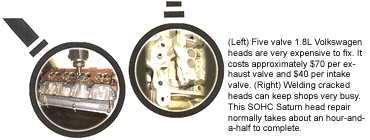Cylinder head work has provided a good income for many of our readers over the years. All engines eventually need a valve job and guide work if they accumulate enough miles. Head work may also be needed if an engine overheats and blows a head gasket, if the head develops a crack, or an OHC timing belt breaks and bends the valves. A customer may also want a set of heads freshened up if the heads are removed while other internal engine work or modifications are being done. There’s also a good amount of demand for performance head work such as porting, polishing, installing oversized valves, stiffer springs and cutting multi-angle seats.
The problem is many of the factors that have driven the need for cylinder head work have changed in recent years. The engines in most late model vehicles are better built and generally last longer than they did a decade or two ago. Passenger car and light truck engines today are engineered for 150,000-mile plus durability. With proper maintenance, many engines can easily pass that mark with little or no need for internal repairs.
There are exceptions, of course. Head gaskets can fail if a vehicle develops a coolant leak and the engine gets too hot. Overheating can also warp and/or crack cylinder heads. If overhead cam timing belts are not replaced at the recommended mileage intervals (60,000 to 100,000 miles typically), a belt failure may result in bent valves and/or a ruined head if the engine is an interference design. Not changing the oil often enough can also allow engines to sludge up and suffer internal wear and damage. But these factors alone are not enough to sustain the demand for head work that was once common in this industry.
Ailing Economy
A soft economy hasn’t helped matters either. Things seem to be turning around. Even so, over a million high paying manufacturing jobs in this country have permanently disappeared and gone overseas or south of the border, and this trend shows no signs of reversing. If people don’t have jobs or the income to spend on major engine repairs, they obviously won’t be spending much on cylinder head work. That, in turn, hurts shops who rely on this kind of work to keep their doors open, suppliers who provide cylinder head parts such as valves, guides, springs and gaskets, and companies who sell cylinder head machine equipment and shop supplies. The ripple effect hurts a lot of people.
Louis Colacurto of Clayton Cylinder Heads in Brooklyn, NY, says his community has suffered a great deal as a result of 9/11. The local economy has been struggling to recover and the city has raised property taxes 25 percent to help offset the lost sales taxes and other revenue. The result has been especially hard on small business owners like Colacurto.
“I’ve been in business since 1977 and my building and equipment are paid for. If I had to pay rent like most other business owners, I wouldn’t be in business today.”
Colacurto says business is down and that most of the work he is getting is “minor stuff.” But he’s not ready to retire yet. He says he loves the rebuilding business and is hanging in there.
Sam Trachtenberg of Cylinder Heads Rebuilt Inc. in Laurinburg, NC is another who laments the decline in cylinder head repairs. “Our business is off 40 percent over the last three years. Money is tight and people in our area just aren’t fixing their older vehicles. Repairs are too expensive. If they have a five- or six-year-old car with a lot of miles on it, it may not be worth fixing. Or if they do fix it, they’ll replace the whole engine, not just the head.”
Irv Krueger of Cylinder Head & Motor Supply in Minneapolis, MN said he’s seeing less and less competition every day. “We only have two or three competitors now. Everybody used to be really busy and we had lots of competitors, but where are they now? They’re all gone.”

Jesse Ashley of Dover Cylinder Heads in Atlanta, GA said the Atlanta market has been “really bad.” He says “take out” motors have taken a big bite out of the cylinder head business. “Installers can get a replacement motor for $800 versus $600 for a rebuilt head and gaskets, so a lot of them are just changing the motor.”
Zero-Zero-Zero
Many blame zero interest and low interest financing on new vehicles as a major reason for the dramatic decline in cylinder head repair work. Some vehicle manufacturers have been offering zero down, zero percent interest and zero payments for up to a year to stimulate sales and keep the iron moving through their dealer showrooms during the economic crunch. With new cars and trucks so affordable, many people have been replacing their older vehicles when they need major repairs.
The high cost of shop labor at the installer level has also had a very negative impact on the demand for rebuilt cylinder heads by driving up the cost for head work. Many new car dealers and independent repair garages now charge $75 to $90 or more per hour for shop labor. The complexity of many late model engines with dual overhead cams combined with terrible accessibility in cramped engine compartments means changing a cylinder head or heads may take 8 to 10 hours or more. When the cost of the gaskets (which have also gone up considerably, especially on late model engines that use multi-layer steel head gaskets) and the cost to recondition, repair or replace the cylinder head(s) are added in, the total repair estimate may be more than many people are willing to spend on a vehicle that may only be worth a few thousand dollars.
No Easy Fix
Our readers are quite resourceful at overcoming the technical challenges of rebuilding late model multi-valve cylinder heads, but the economic issues are much harder to overcome. When it’s cheaper to buy a new vehicle or a newer used vehicle with low rate financing, many people will opt for the low monthly payments rather than fork over $1,000 to $1,500 or more to repair an older vehicle.
At the same time, there’s not much in the foreseeable future that will bring down the costs to repair late model multi-valve cylinder heads. The hourly labor rates that installers charge will continue to climb due to rising health care and insurance costs, higher property taxes, and a shortage of highly skilled technicians who can work on late model engines. What’s more, engines will continue to become even harder to work on as “Variable Valve Timing” and “Displacement On Demand” become more common. Consequently, repair costs will remain high and the demand for cylinder head work will continue to be impacted.
It’s a grim forecast for many of our readers – but it isn’t the end of the cylinder head rebuilding business for those who are adapting to the changes and are developing new strategies to move ahead. The good new is:
- An anticipated rise in interest rates may slow or even partially reverse the low rate financing of new and used vehicles. That should make trading up less attractive when repairs are needed, and hopefully generate more cylinder head business for our readers.
- The high cost of some replacement parts that are currently available only through new car dealers may come down as aftermarket sources for these parts become available. Some parts may never be available from aftermarket sources because they are in such small volume (many Daewoo engine parts, for example). But if there is enough demand and prices are high, somebody will come out with an alternate source of supply.
Gerard Ramey of R.A.M.S. Cylinder Heads in St. Louis, MO, said parts for the Volkswagen 1.8L head (the one with 5 valves-per-cylinder) are very pricey: $70 each for exhaust valves and $40 for intake valves. When the timing belt on this engine breaks, it bends the valves. The tensioners are also very expensive to replace as is the head gasket. As a result, the head is very expensive to fix.
- Performance work will continue to provide healthy margins for those who have the know-how, equipment, experience and reputation to do this kind of work. The sport compact car market has exploded in recent years, and aftermarket performance heads are becoming available for some of the more popular Honda, Mitsubishi and other engines.
One of the fastest and easiest ways to boost the power output of any small displacement naturally aspirated engine is to make it breathe big. This can be done by installing a higher lift, longer duration performance camshaft, replacing the stock intake manifold with a larger, higher velocity manifold, bolting on a forced induction system like a supercharger or turbocharger, and/or porting the cylinder head.

Hogging out the ports with a hand-held die grinder can often hurt airflow more than it helps. Ports must be contoured to maximize airflow and velocity, and the only way to know if a change improves airflow is to test it on a flow bench.
Other head modifications such as narrowing valve guide bosses, shortening the amount of guide that protrudes into the port, smoothing and blending the bowl area under the valves, matching the ports to the manifolds, and reworking combustion chambers to unshroud the valves are all tricks performance head builders use to squeeze more power out of pint-sized heads. The combustion chambers in most 4-valve heads are pretty cramped so there’s not a lot of room for oversized valves. So changing the angle of the valve seats and using 5-angle cuts instead of 3-angle cuts can improve airflow.
Survival Strategies
Trachtenberg of Cylinder Heads Rebuilt Inc., says he’s focusing more on new car dealers these days. “Dealers get a lot of cars that have overheated. Fixing the engine with original equipment parts can cost up to three times as much as a remanufactured head, so I’m trying to help them sell more affordable repairs on cars that are out of warranty.”
Trachtenberg says dealers have the tools and the know-how to work on late model multi-valve engines, and consequently have fewer warranty problems on the work they do. “A lot of corner garages that used to replace cylinder heads don’t do head work anymore because it’s become too complicated and expensive for them to do it.”
Trachtenberg said he is also diversifying his business and getting into heavy-duty diesel engine parts and repair. He also said he is doing more complete engines on an exchange basis, but has no interest in doing engine installations.
“Crack repairs also helps keep us in business. It’s our forte,” said Trachtenberg. “One of the more difficult repairs is on Saturn SOHC heads. The head cracks in the cam journal. To fix it, we cut off a corner of the head, weld the crack, then reweld the corner of the head back on. It takes about an hour-and-a-half to make the repair but it saves the head.”

Another who has found salvation in crack repairs is R.A.M.S. Cylinder heads. Ramey says specializing in crack detection and repair has been good for his business. The secret is finding all the cracks and doing a thorough job of welding the cracks. “We offer a one year warranty on our work and have a comeback rate of maybe one head in 600,” said Ramey.
Richard Moore of Auto Motive Machine in Miami, FL, says the turning point for his business was learning how to TIG weld aluminum. That enabled him to specialize in aluminum heads, and today 90 to 95 percent of the head work he does is on aluminum heads, mostly high end European models like Mercedes and BMW.
“We were doing a lot of Toyota heads, too, on engines with the oil sludging problem. But Toyota changed their warranty policy and now tells dealers to just clean and reinstall the heads. That hurt our business.”
Moore said he’s one of the higher priced shops in Dade county and doesn’t try to compete on price. “Three things are important in this business: price, service and quality. You can pick any two but it’s hard to get all three.
“We’re also doing more high performance work, and my son Chris is now doing a lot of porting work. We’re also working with the University of Miami automotive racing program. They do a lot of our flow testing. We don’t have our own flow bench yet but are considering buying one.”
Moore said one problem he sees on a lot of late model multi-valve heads from the Miami area is severe corrosion caused by people running straight water in their cooling system instead of an antifreeze/water mixture. Guide wear is also a common problem in many German heads, which requires replacing the guides. “We generally replace same with same (bronze with bronze in the case of the German heads) because that’s what our customers want. Since business has been down, I’m stocking fewer parts than I used to stock. But I try to stock as many guides as I can so I have the parts I need on hand.”
Over half of the heads Moore sees also need to be straightened. But if the cam journals need to be line bored, he says it is often cheaper to find another core with good cam bores that does not need boring or honing.
“Cleaning used to be a bottleneck in our shop. But since we bought a glass bead system, the cleaning goes much faster and has really speeded things up.”
Jesse Ashley of Dover Cylinder Heads says one time and money-saving technique they use on most of the aluminum cylinder heads they do is to install bronze guide liners. “The liners really work great for us and we’ve had no problems with comebacks. There are a few engines, though, like Chrysler 3.0L V6 and some of the Honda engines where we replace the cast iron guides with new ones.”
Ashley says crack repairs are “a piece of cake” on most aluminum heads, and that they can usually fix any heads that need to be welded. He also said many aluminum multi-valve heads also need to be straightened, especially if the engine has overheated. When straightening is required, they charge a flat fee of $30. As for line honing, it depends on the head. On a Ford 4.6L, for example, if only one or two cam journals are bad, it’s worth doing. But if more journals are bad its cheaper and easier to find another core.
Ending On A Positive Note
Hugh Baskins of Alabama Cylinder Heads in Rainbow City, AL, said his business is up. “The market has been undergoing a contraction, and at the end of the cycle the big have gotten bigger. We’re facing the changes and learning how to manage them.”
Like Auto Motive’s Moore, Baskins agrees that three things count in this business: “Number one is quality, two is speed of delivery and three is price.” However, he feels that all three are of equal importance. “If you can accomplish all three, you’ll do just fine.”
“Our Patriot Performance line of heads is doing really well, and the margins are huge compared to traditional parts. We’re also making new heads for some applications, and are having brand new cams, valves, springs, locks and retainers made for us. We will also have a new head soon for the Honda 1.6L, which is a hot item. We are also doing porting work on Saturn heads.”
Baskins said the core inventory isn’t as deep as it used to be, but
it is wider. They are also doing more crack repairs and have two full-time welders fixing cylinder heads. Their ability to find leaks has also been improved thanks to a new pressure tester. For cleaning, they are using soda that leaves a nice, bright shiny finish.
The cylinder head business is certainly changing and may never be the same again. But for the survivors, it is worth it.













